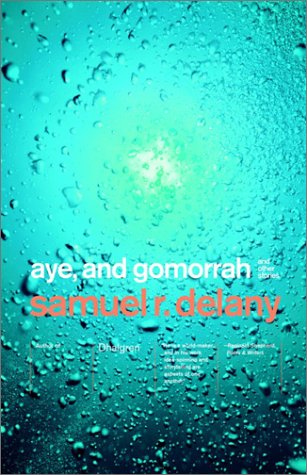I have three collections of Delany’s short fiction. I bought all of them new when they were new, none of them are presently available. I don’t own the collection that is available, Aye and Gomorrah, but I think most of the stories I want to talk about are in it. I own Driftglass, which I’ve had so long I couldn’t bear to get rid of it when I bought Driftglass/Starshards which contains all of the original collection and some more stuff. I also own Distant Stars, which I think must have come to Britain as ballast because I bought it incredibly cheaply in a remainder bookshop.
Almost all of Delany’s short stories are gems. His word and sentence level writing are always astonishing, his world building is memorable, and his ideas are cool and unusual. It’s hard to imagine stories better than these. When I’m reading Delany I sometimes think I should just stop trying to write.
I often find when I re-read a whole pile of short work from one author that I see the writer’s concerns show up because of the repetition—with Delany there isn’t any repetition. If there are any themes here apart from compassion for humanity they are are “the lives of ordinary working people in the future” and “unconventional ways of building families.” The second is quite a usual thing to do in science fiction, it’s something that’s interested Heinlein, Le Guin, Foster and lots of others. The first, however, is notably unusual—very few people have explored the undersides of shiny spaceship futures. Oh, maybe you get things like “Time Considered as a Helix of Semi-Precious Stones” which is about a thief moving between Earth and Triton and Mars. I can’t think of anything that’s really like it, but there are plenty of stories about thieves and lowlives, if not in worlds made out of words this well. But there’s really not much at all like “The Star Pit.”
The central character of “The Star Pit” tunes up and fixes spaceships. He does this the way people run little garages that fix cars. His hands are grimy. He cleans graphite lube from under his nails with his slide rule. He’s a reformed alcoholic. What the story’s about is what it means to feel trapped, and the context is that humanity has filled the galaxy but most people go mad outside it—all but a lucky few who are a different kind of mad already. The Star Pit is at the edge of the galaxy, as far as normal people can go. And Delany gives us this story about a regular guy who works there fixing spaceships and missing his family with a whole galaxy to move through but banging his head on the fact he can’t get outside it. It’s one of those stories where there isn’t anything, except there’s everything. There are other stories here that are about the undersides of futures—”Corona” is about an ex-con spaceport worker and a little girl who is telepathic. “Driftglass” is about people with gills working underwater. I don’t know why we don’t see more of this kind of story in science fiction. It’s not as if in the future we’re all going to be middle-class or destitute. We get the destitute—it’s mechanics who have worked their way up to owning their own little shop we don’t see enough of. Delany’s good at writing about people working too, having adventures by all means, but having adventures while going their jobs.
“Aye and Gomorrah…” first appeared in Dangerous Visions and I think it was the first story where Delany wrote directly about his experience of homosexuality. In this future, people who work in space have to be neutered at puberty. So there are lots of spacers, and of course there are people who are attracted to them—frelks, whose kink is having sex with people who can’t have sex. It’s a story about some spacers coming to Earth on furlough, it has a strong sense of Earth as a whole planet, almost an alien planet to them. It isn’t a dangerous vision any more, but it’s still a striking one.
These stories were all written in the sixties, and were part of what established Delany’s reputation. In the later part of Starshards there are some autobiographical stories written in the eighties. This mirrors Delany’s career—he really hasn’t written much SF for quite a while. His later work has tended to autobiography, criticism, erotic writing, and most recently a mainstream novel, Dark Reflections. I find the autobiographical stories interesting but not wonderful, and that tends to be my general reaction to his work. The science fiction is wonderful and not like anything else, the stuff set in this world is good, but not earth-shaking. I wish he’d write more science fiction, but I’ll take what I can get. Meanwhile, if you haven’t read his short work, do.
Jo Walton is a science fiction and fantasy writer. She’s published eight novels, most recently Half a Crown and Lifelode, and two poetry collections. She reads a lot, and blogs about it here regularly. She comes from Wales but lives in Montreal where the food and books are more varied.










